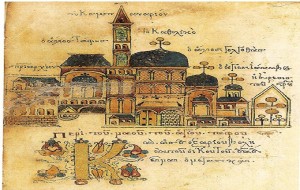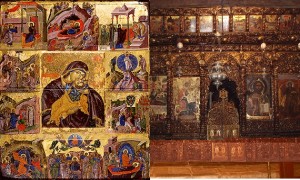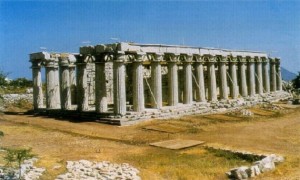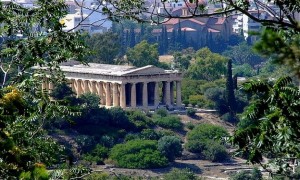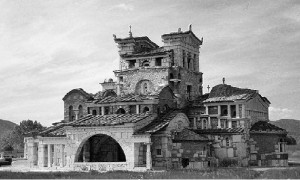Byzantine Iconography οn Mt Athos
7 July 2019The Protaton, the Monastery of Vatopedi and the Cretan School
The Holy Mountain has been the great centre of Orthodox art since the fall of Constantinople. But art flourished on Mount Athos much earlier than that, as is shown by some icons and miniatures that have survived the severe vicissitudes through which the Holy Mountain has passed.
Of the older iconographic works, there are the remains of the mosaics in the katholikon1 of the Monastery of Vatopedi. They comprise the following: Christ on a throne flanked on either side by the Holy Virgin and Saint John the Baptist, situated above the central door of the narthex, with an inscription of the eleventh century; the Annunciation of the Holy Virgin, on the wall of the narthex by the side of its central door; and Saint Nicholas, above the smaller, right door of the narthex. These works have the wisdom and the largeness of plan that characterize the mosaics of the eleventh century in general. To the same period belong the two mosaics of the Monastery of Xenophontos, which represent Saint George and Saint Demetrios. These appear to be sections that were removed from the walls of a church once decorated with mosaics and made into portable icons by being glued onto panels. To the period before the fall of Constantinople also belong the mosaics of Saint John the Theologian, in the treasure room of the Monastery of Megisti Lavra; the Crucifixion and Saint Anna, at the Monastery of Vatopedi; Saint Nicholas, at the Monastery of Stavronikita; and some others.
The panel icons that belong to this period also are relatively few. The more important ones include the many miraculous icons of the Holy Mountain, which are famous throughout the Orthodox world, such as the Panaghia Portaitissa, at the Monastery of Iviron; the Antiphonetria, at the Monastery of Vatopedi; the Triherousa, at the Monastery of Chilandaxi; the Gorgoepekoos, at the Monastery of Docheiariou; and some others of smaller dimensions such as the small diptych icon that represents Christ and the Holy Virgin, known as “Ta Ninia.”
In contrast to the small number of mosaics, frescos, and panel icons created before the fall of Constantinople, the miniatures of the manuscripts that go back to that period are numerous.2 Among the more ancient ones are the miniatures of the eleventh-century Psalter at the Monastery of Pantocratoros, the Octateuch at the Monastery of Vatopedi, and the Book of the Gospels at the Monastery of Iviron. These miniatures are rare masterpieces, showing not only extreme patience, for which alone they are admired by many non-experts, but also unsurpassable perfection. Many of them have the perfection and clarity of great mural compositions. In regard to their delicacy, quality, and the nobility of their coloring, they are incomparable and unique.
Of the frescos, the oldest are those in the katholikon of the Monastery of Vatopedi and in the Church of the Protaton, at Karyes. Certain remnants, very few and mostly disfigured, such as those in the cell of Ravdouhos near Vatopedi and a few other little chapels belong to an earlier period.
The Protaton
The frescos of the Protaton3 are attributed to the painter Panselenos, whom tradition has made into a fabulous figure. From the style of his work, he appears to have been in his prime in the fourteenth century, and a contemporary of the artists who adorned with paintings certain churches in Serbia, such as those at Pee and Studenica, Saint Clement at Ochrida, and others.
In general, the frescos of the Protaton have the characteristics of the works that were made at that period, but they are most clearly distinguishable from other frescos by their monumental breadth and comprehensive simplicity, by their quiet and strong tone, by the simple yet mysterious sweetness of the coloring, by a certain special ancient dignity, and especially by the very profound inspiration that emanated from an extraordinarily gifted hand, which colored with a certain free yet most clear quality every line, every brushstroke, and every area. The most simple and archaic elements are combined in a peculiar manner with a certain artistic wisdom and unparalleled knowledge in these works. Vehemence and soberness, the most touching naiveté and the greatest technical keenness, and restful forms and fervor coexist in them. And on top of all this spreads the blessedness of piety, whose spiritual fragrance strongly impresses its seal upon the works of Eastern iconography. Panselenos is one of the most original men of art. His work should preoccupy many in the future.
The Church of the Protáton is like a sacred ark of art. Its oldness and its mysterious dim light, which is diffused in its interior, intensify the impression produced by the frescos, and the visitor is seized by religious awe and feels that he must venerate them, rather than merely look at them as works of art.
On the first strip of this basilica, immediately below the ceiling, the ancestors of Christ4 are painted in two rows, on the right side and on the left, on the long, side walls of the building. These figures, most of them of old men who lived for centuries, instil astonishment and religious awe. These extremely old men and patriarchs are indeed the ancestors of the human race. Their heads are all of unsurpassed magnificence, immersed in deep thought; power, piety, and old age are united in these faces. The eyes are deeply set; the cheekbones are strongly protruding; the noses are curved or snubby; the wrinkles are of unspeakable expressiveness; the brows are strong and contracted. Some have long beards; others have round ones; still others have rushlike beards, beards that have turned yellowish, or curly ones. Some have their white hair divided into two parts, others into three, and still others into four parts. Some have long hair, others have curly hair, and a few are bald. Their poses are decorous and hieratic; their movements, imposing yet modest. Nowhere else have such saints been painted, nor with such art.
On the strip immediately below, events from the life of Christ are painted. These include the Nativity, the Purification of the Virgin Mary, Twelve-year-old Jesus in theTemple, the Baptism, the Transfiguration, the Crucifixion, the Descent into Hades, and the Pentecost. All of them were painted with vigor. There are also some incidents from the life of the Holy Virgin, such as the Birthday Feast of the Holy Virgin and the Presentation of the Holy Virgin. The following are wonderful works of art: The Holy Virgin and Symeon at the Purification,Saint Johnthe Baptist, Christ and the Righteous Men in the Descent into Hades, the Apostles at the Ascension, and the Little Girls at the Presentation of the Holy Virgin.
On the lowest strip military saints, holy and hieratic, are painted. Among the warrior saints the following stand out: Saint Mercurios, Saint Eustathios, and the two saints who both bear the name Theodore. However, the holy ascetics and anchorites are the most wonderful, because Panselenos has imprinted upon them the mystical grandeur of the old men of Orthodoxy. Each head of all these saints seems more marvelous, as one studies it, than the others. Among the saints are Saint Anthony, Saint Euthymios, Saint Ephraim of Syria, Saint Neilos, Saint John Climacos, Saint Maximos the Confessor, Saint Theoktistos, Saint Athanasios of Mount Athos, and Saint Cosmas the Poet. Among the hierarchs, those that stand out are the saints Nicholas, Spyridon, John the Merciful, Dionysius the Areopagite, and Hierotheos.
Of the frescos that adorn the arches, we must note Noah, Moses, Melchizedek, Samuel, Elijah, Jeremiah, and Daniel. Most of them are marvelous works, for one who is experienced in this art.
Further, let us mention the Reclining One, or Christ as a babe, sleeping, according to the Scriptural statement: “Having couched, thou slept as a lion.”5 This icon has been trumpeted as a masterpiece by some who have visited the Protaton, but they had little knowledge of the art of iconography and judged it by their superficial knowledge and sentimental disposition, a point of view that tends to make one extol everything that looks young and rosy, and perhaps casually beautiful. The Reclining One is not one of the more powerful works of Panselenos; it is listed among his secondary works. We also note the head ofSaint John the Baptist, at the right hand side of the iconostasis, on the wall. This, too, has been greatly praised, but with more justice, since it is indeed full of power and religious spirit.
These precious works of the Protaton are at present in bad condition, and threatened with destruction, which may suddenly come some day -and other similar works by the hand of Panselenos do not exist anywhere else.6
The Monastery of Vatopedi
Let us now turn to the frescos that adorn the katholikon, or the large church of Vatopedi, one of the most important and largest monasteries of the HolyMountain. These frescos are probably more ancient than those of the Protaton. In power of inspiration and in execution and originality they in some ways surpass those of the Protaton, though they lack the simplicity and breadth of the works of Panselenos. Unfortunately, they have been disfigured by later repairs. Where they are untouched, the trained eye is astonished by their originality, even though the colors, due to smoke7 and oxidation, have reached the monochromic state, which characterizes works of later times. The inspiration that sprang from the vigorous personality of the painter who made these frescos gave them extreme clarity; it is like that of a maker of bas-reliefs. Excited figures moving with fervor; austere and vigorous expressions; compositions full of drama; repeated and involved but perfectly unsurpassable folds; buildings of some mythical architecture, variegated by basreliefs and ornaments; rare artistic inventions, which do not, however, lapse into empty emphasis; and, above an, a certain tone of deep mystery envelops everything in that unique art, in that initiation-into-the-mysteries effected by painting. Such is the intensity and wealth of this art that it becomes somewhat heavy, more closely packed and involved than is requisite.
Of the large compositions, the following are notable: the Nativity, the Baptism (though the figure of Christ has been retouched in many places), the Funeral Lamentation, the Entrance intoJerusalem, the Crucifixion, the Descent into Hades, the Ascension, and the Dormition of the Holy Virgin. Of the smaller compositions, the following stand out: the Last Supper, the Washing of the Apostles’ Feet, Christ Speaking to the Apostles, the Birthday Feast of the Holy Virgin, the Benediction of the Priests, and above all certain incidents from the Passion, painted in the narthex, of a very sharp and almost painful dramatic intensity, such as the Agony, the Whipping, the Removal of Christ from the Cross, and the Lamentation. Of the isolated figures, we note, among others certain prophets: Habakkuk, Joel, Malachi, Zechariah, and Gideon, and also the saints Artémios, Nicetas, Romanós, Próvos, Andronikos, and Tárahos. All have the living character of portraits of the Hellenistic period.
These unique works must in time be cleaned of the additions that have been made, washed, and then studied thoroughly. They are among the most amazing Byzantine paintings, truly a buried treasure.
The Cretan School
The Cretan painters appeared on theHolyMountainabout the sixteenth century and represent Hagiorite iconography proper. The style of this school was later transmitted to all ofGreece, diversified according to the place and the iconographer. Many of the Cretan painters first worked in the monasteries of Meteora, but their mature, works were executed on the HolyMountain.
The leader of this school is considered to be the monk Theophanes. The frescos in the katholikon of the Monastery of Lavra are his works.
The character of these works is vigorous (not weak, as thought by some who do not know the iconography of the East), full of religious heroism and feeling, a reflection of the steadfast spirit of Greek Orthodoxy. The folds of the garments and the flesh look as though they were carved with a chisel; the physiognomies are strong, with a certain sternness in their glances; the gestures and poses are hieratic and at the same time dramatic; the compositions are solid, the coloring is warm and mystical, and the brush strokes are impetuous but made with wise circumspection.
The representations in the dome were destroyed and have been painted again, but the rest of the wall paintings remain almost intact, except for repairs to the background and some secondary details, which do not alter their original character. Episodes from the life of Christ, Saint John the Baptist, and the Holy Virgin cover the walls, the barrel and cross vaults of the church, forming a mystical veil that envelops the worshiper.
The following compositions are outstanding: the Baptism, the Transfiguration, the Raising of Lazarus, the Entrance into Jerusalem, the Last Supper, the Betrayal, Jesus Being Judged by Pilate, the Crucifixion, the Descent into Hades, Christ Appearing on the Seaof Tiberias, the Pentecost, and certain incidents from the life of the Holy Virgin, especially the Dormition. But the most arresting works of Theophanes are his military saints, a veritable “divine drawing-up in battle-order of the array of the Lord.” Nowhere else has the heroic and steadfast, and at the same time melancholy and mystical, spirit of the Eastern Church, which has endured so much suffering, been imprinted with so much power and religious exaltation. These holy chieftains are represented in an impressive array, covered with breastplates, with shields of various forms, with exotic helmets, with long swords, spears, quivers, clubs -in short, with a multitude of arms whose sight reveals clearly to the beholder the turbulent but at the same time heroic character of the period. The faces are ascetic but also warlike, tanned, with big eyes shining with ardor that are fixed on the beholder. In his soul are inscribed forever the forms of these martyr-warriors, who, in the words of the Apostle Paul, did not fight “against flesh and blood, but against the principalities, against the powers, against the world rulers of this present darkness.'”8 Such are Saint Theodore Teron, Saint Theodore the Army Commander, Saint George and Saint Demetrios, Saint Procopios, Saint James the Persian, Saint Mercurios -all of them on foot.
Among the frescos there are also the conventional portraits of the founder emperors, Nicephoros Phocás and John Tsimiskís.
Above the door of the Church, inside, in one of the corners of the Dormition of the Holy Virgin, the restorer’s inscription is preserved. It ends thus: “Through the hand of Theophanes, the monk.” The paintings in this church were made in 1535. Earlier and less perfect works by Theophanes are to be found in the small monasteries at Meteora. In some of his compositions he had as prototypes etchings of Italian art, as in the case of the Massacre of the Infants, the Appearance at Emmaus, and the Crucifixion (the guard of soldiers); however, these have been completely assimilated by other elements, thanks to the strong originality of Theophanes.
The wall paintings in the refectory of the Monastery of Lavra were also done by Theophanes and his pupils. And the figures of saints and anchorites -austere works, full of the pulsation of life -occupy a prominent place there. Notable are the saints Neilos, Joasaph, John Damascene, Cosmas the Hymnist, Joannikios, the brothers Theodore and Theophanes Graptos, Ephraim of Syria, Martianos, Athanasios the Athonite, and Kyriakos the Anchorite.
Another Cretan iconographer is Tzórtzis, who painted the katholikon of the Monastery of Dionysiou, in 1547. Other Cretan artists, all anonymous, painted the katholika and refectories of Docheiarlou (1568), Ivíron, and Koutloumousiou. These works are very important. Their general character is similar to that of the frescos of Lavra, but the details are more hieratic, more formal, more ascetic, and more stern. They are executed with strong religious feeling and much sobriety and contrition. Their formal aspect conceals great excellences and a deep knowledge of technical means. The coloring is simple and very warm; the design is simple and severe; and the general character is doctrinal and mystical.
The wall paintings of the Monastery of Dionysiou are made with greater delicacy. Also greater care is given to design than in the frescos of the Monastery of Docheiariou, which are more original and abrupt.
Anthony the Cretan painted the old katholikon of the Monastery of Xenophontos, in 1545. However, his works have been pitifully disfigured by recent repainting.
The wall paintings of the side chapel at the Monastery of Saint Paul (1553), the work of an anonymous painter, are quite remarkable. Although the arrangement, the composition, and the general character of these murals are similar to those of the Cretan iconographers, the execution differs from that of the other frescos of the Cretan school. The colours are lighter, the design is smoother, and the whole work is more personal.
The wall paintings of Molyvocclesia (1537), a small church of a certain cell near Karyes, are also very noteworthy for their exceptional quality, particularly their design, Because of their style, they are attributed to the Cretan school, but the types of composition and the forms are actually a mixture of elements of the Macedonian and the Cretan schools,
Another exceptional group of wall paintings decorates the church of the cell of Saint Procopios (1547).
1. The main church of a monastery.
2 Byzantine iconographers made such miniatures as early as the fourth century.
3The principalchurch of Karycs or the Protaton. the capital of Mount Athos.
4 Forty-two altogether.
5 Genesis 49: 9.
6 This was written in 1949. Recently, the Greek Archeological Service decided to make secure and to clean the frescos of theHolyMountain. The work of restoration at the Protaton is now in its final stage.
7 The smoke of candles and incense.
8 Ephesians 6: 12.
Constantinos Cavarnos, Byzantine Sacred Art, New York: Vantage Press Inc., c 1957.








